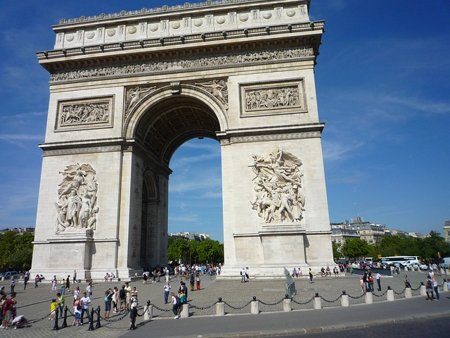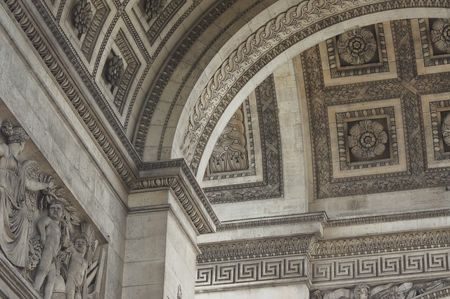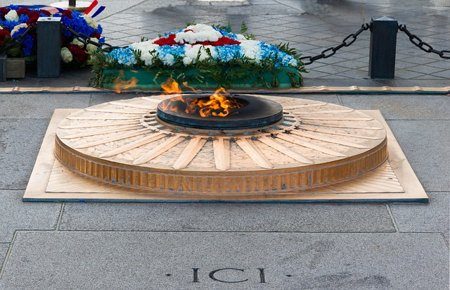The Arc de Triomphe is indeed a triumph of Parisian history and it stands triumphantly on the right bank of river Siene at the junction of 12 radiating avenues on a ring shaped plaza. An ode to the glory of Napoleon, various phases of the marvelous arch were completed during different periods of achievements of Napoleon… though construction started on 15th august 1806 (Napoleon’s birthday). Today it is easily one of the best attractions of France and it symbolizes military power, national integrity and victory. All national celebrations of importance happen around the arc; the principal ones are 11th November, 14 July and 8th May.
The arc was commissioned in 1806 after the Austerlitz victory and it took 2 whole years to lay down the foundation. In 1810 a wooden mockup of the arch was made on the event of Napoleon’s marriage to Marie Lousie of Austria. Jean Francois Chalgrin, the principal architect and designer of the arc took inspiration from the arch of Titus in Romanic times but he superseded the size conceptualizing a 50 m high 45 m long arch that has 22 m width with large abandoning columns. After some years of stalled work Lois XVII ordered progress on the arc de Triomphe in 1823.

It was however the architect duo Goust and Hoyot who successively completed the arc construction and design under the patronage of Louis Phillipe around 1836 and it officially opened on 29th July 1836. The sculptures, reliefs, figures and embellishments of the arc were created by the best designers and sculptors of 18th century France like James Pradier, Jean Pierre cortot, Antoine Etex etc. from 2010 a restoration project headed by Etienne Poncelet (chief architect of historical monuments) is underway.
Napoleon’s remains were passed under this arc before they were laid down at Invalides. General Charles Gaulle laid down the white cross of Lorraine under the arc at a site where the tomb of Unknown Soldier stands now.
Many important events happened under the arc like the 1919 event of Charles Godefroy flying his fighter plane under it and the passage of the remains of luminaries like Ferdinand Foch and Victor Hugo under it. The French troops paraded here after victorious military jousts and the annual Bastille Military parade is a famous event. In fact it was always a custom to conduct a victory parade near the arc… invaders like Hitler have also done it in the past. Postage stamps were issued in 1945 which showed a jubilant American army marching with the arc in the background marking an iconic day in the history of France.
Structure and Design
The arc de Triomphe has an astylar design created by Jean Chagrin… inspired by the neoclassical roman architecture style of the arc of Titus. There are 4 sculptural groups at the base of the arc on each of the 4 pillars.
Le Depart de 1792 is a sculpture group created by Francos Rude and this glorifies the liberation of French first republic and the agitation which caused it. A winged persona of liberty above a group of volunteers is shown in the sculpture….it’s also known as Les Marseilles and is undoubtedly the best known part of the arc.
Le Triomphe de 1810 created by Jean-Pierre Cortot is an ode to the treaty of Schonbrun…this sculpture has Napoleon being crowned by the Goddess of victory. La Resistance de 1814 is a sculptural creation by Antoine Alex and it celebrates the attempts of the French to shield themselves against the allied armies in the 6th coalition war. La Paix de 1815 is a sculpture group by Antoine Elex that celebrates the Paris treaty.

Look at the inner walls of the monument… 660 names are inscribed here along with names of generals of French empire. The attic over the cluster of soldiers has a group of 30 shields that have the names of big victories of French history with an emphasis on the ones brought in by Napoleon.
The inner columns have details of the French victories under Napoleon. The arch facades have 6 gorgeous reliefs that testify to some important moments of French revolution and Napoleon’s era. The southern façade has reliefs of Genera Marceau’s burial and the Aboukir battle while the North façade has the Battle of Arcole and Fall of Alexandira. The east façade has the Battle of Jenappes while the west façade has the Austerlitz battle.
The ceiling blooms with 21 perfectly symmetrical roses and the large arcades are decorated with mythical figures of Roman lore. The foot of the monument has many plaques including the De Gaulle speech Plaque and the Proclamation of Republic plaque.
Lying beneath the arch is the Tomb of Unknown Soldier; a monument dedicated to the millions of faceless soldiers who are killed in wars… it contains the body of one unidentified soldier. The tomb was interred on 1920 Armistice Day and is famous for containing the first eternal flame in east and west Europe. Jacqueline Kennedy was inspired by this flame and had a similar one placed by John f Kennedy’s grave in Virginia.

The flame is rekindled each day at 6.30 p.m… it is a circle shaped bronze shield whose heart has a cannon muzzle. A frieze of swords jumps up from the muzzle. Every 11th November (anniversary of the armistice) there is an official ceremony to honor the contribution of thousands of soldiers who die faceless in battles.
A staircase comprising of 284 steps goes up to the monument top from the ground. A lift will go part of the way (mid-level) but then 46 more steps will go up to the very top where there is an observation deck. An astonishing view of Paris on offer and if you can catch the moment when the Eiffel lights (clearly visible) are switched on…its pure magic. The tiny interactive museum lies one level below the observation deck.
Since 2007 a permanent exhibition conceptualized by Maurice Benayoun and Christopher Girault is hosted here. There is a lot of data, photographs and exhibits here showing why the arc was built and its current usage trends. The media and steel installation inside is critical of the symbolism of national monument ….recently groups of intellectuals and activists have been debating the moral stance of glorifying war.
Pause for some moments as you pass under the arc and think about the momentous moments of history that have happened right at this spot. The Arc de Triomphe is more than a tourist attraction; it’s a symbol of fierce military pride and an undying national spirit.
Open Hours, Tours & Tickets
The Arc de Triomphe is open from 10.00 a.m. to 11 p.m. from April to September and from 10.00 a.m. to 10.30 p.m. from October to March. It is closed on 1st Jan, 25th Dec and on the mornings of important national events (Nov 11, May 8th and July 14th).
Tickets cost around 9 Euros per person. You can skip paying for the ticket if you have a Paris Museum pass. Walking around the base of the arc is free…the fee is for those who wish to go up to the museum and observation desk.
You can buy entry tickets online (including skip the line option and terrace access) or book guided or self-guided tours through this Viator site.
Try visiting after 6.30 p.m. when the flame of the tomb of Unknown Soldier is re-lit and the avenues around (especially Champs Elysees) are bathed in lights. Late November to mid-January there are lovely holiday lights around this area and the celebrations on Christmas Eve and New Year’s Eve are outstanding with frequent video and light shows.
Location & How To Reach
The Arc de Triomphe is located at the heart of Place Charles de Gaulle/ Lace de l’Etoile at the west end of Champs Elysees in the 8th arrondisment of Paris. It’s at the center of the historical axis of Paris (L Axe Historique) that’s a sequential display of monuments and thoroughfares on a route which goes from the Louvre Palace courtyard to Paris outskirts.
The nearest RER station (line A) to the Arc de Triomphe is Charles de Gaulle Etoile. The Airport is very near so seeing the Arc while on your way in/ out of Paris is a viable option.
The nearest metro station is also Charles de Gaulle Etoile and metro lines 1, 2 and 6 can be used to access it. You can take the hidden underground passage from Champs Elysees to come up to the base of the Arc.
Don’t think of driving around this area…the traffic is the wildest. However if you are caught in a traffic snarl nearby then take quick pictures of the Arc and stare hard….it’s the easiest and least troublesome way to enjoy an uninterrupted view of the French national pride. Never attempt to cross the road to reach the arc…always take an underpass.
It’s possible to explore the Place de la Concorde that’s just 2 km away. The tempting Champs Elysees with its grand embassies, official buildings, art galleries and Haussmann haute couture boutiques stand here. This is a very tourist laden location so you might want to escape to the Siene banks for some tranquil walks. The Grand Palais, Petit Palais and the Guerlain perfumery shouldn’t be missed while you are around here.
You can head off to Bustro Nome Paris (Kleber Avenue) for some classy international food or the Café Caesar (Carnot Avenue) for some Italian Pizza…they are both within 200 m of the arc. For dinner with a view of the Arc… L Etoile 1903 on Wagram avenue is a good choice while L Atelier de Joel Robuchon on Champs Elysees is the place to go for an expensive sophisticated gastronomy experience. For just a few quick bites; Café Lateral on Mac Mahon Avenue and Bagelstein on Carnot Avenue will serve your needs. Even if you don’t go inside, steal a peek into the historic Foquet restaurant and the Laduree tea room.
Address
Place Charles de Gaulle (8th arrondissement of Paris)
Phone: +33 (0)155 377 377; Official Website
 A travel addict. Still celebrating the day when he quit his high-profile corporate job to pursue his passion for travel writing.
A travel addict. Still celebrating the day when he quit his high-profile corporate job to pursue his passion for travel writing.